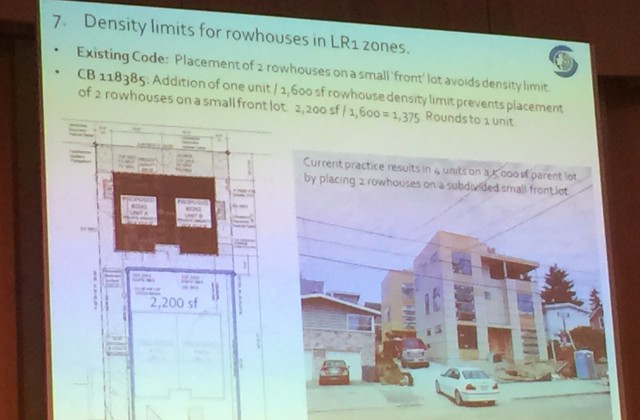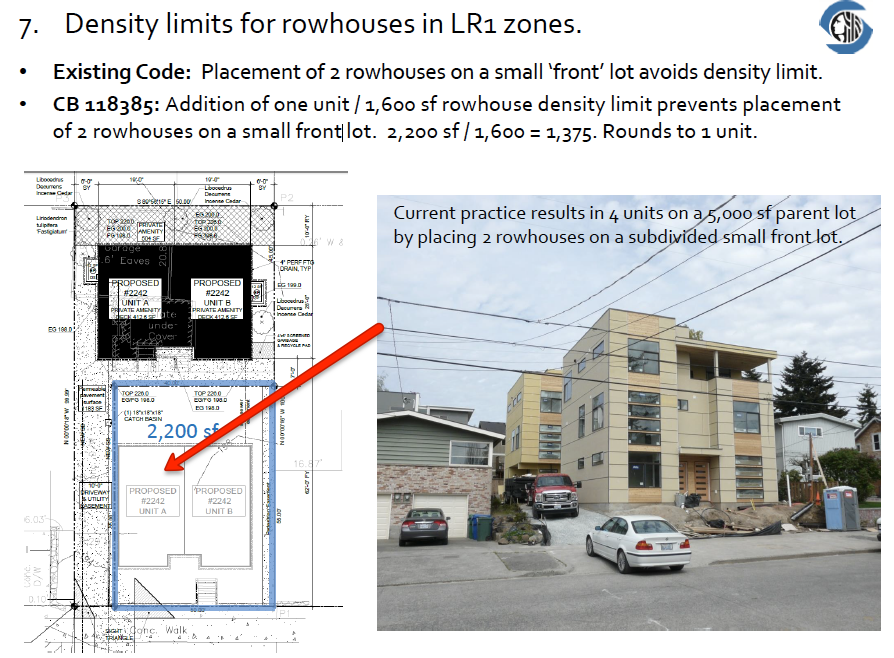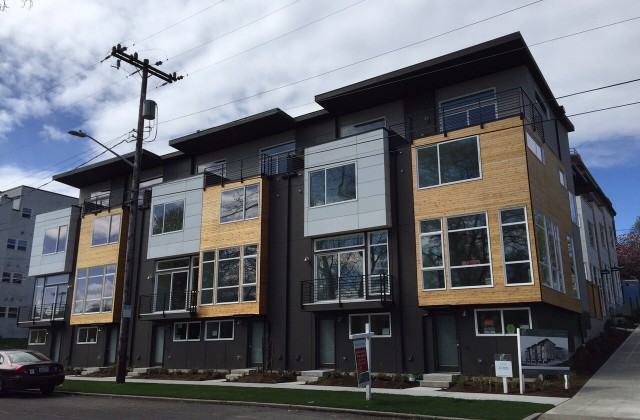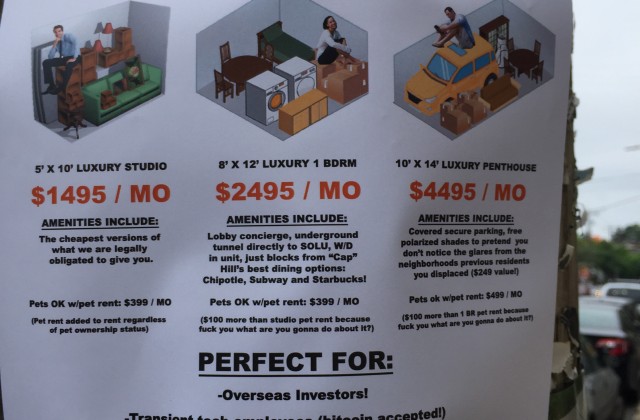O’Brien Plays Politics with Design Review, Mayor Opposes.
Why would Councilmemeber O’Brien add this onerous new requirement to projects in the LR2 zones. Politics pure and simple. O’Brien is running for reelection and he’s heard lots from angry neighbors about projects in the low-rise zones, including LR 1 and 2 like this one in Crown Hill.
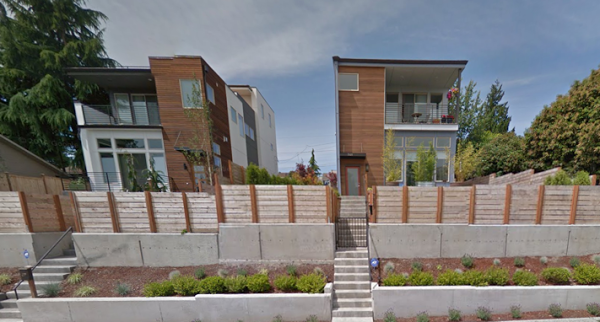
Here’s part of the neighbor’s notes about their meeting with O’Brien:
Notes from Meeting with Mike O’Brien 10/14/2014
Frank Scarabino, Jim Nicholls and I met with Councilman Mike O’Brien to discuss the planned development project in our neighborhood. For all the preparation and points we presented it seemed there was ultimately little he could do for us, especially as the developer’s application is vested which means the application will be considered only under the applicable code at the time the application was filed. So even if we could get the property rezoned today it would be too late.Mike offered to contact the developer, Oleg Afichuk of Westcoast Homes, to suggest he set up a meeting with some folks from our neighborhood, to hear out our grievances and at least initiate a dialogue, but he wasn’t sure at the moment if that would breach some protocol, so we’ll find out soon if that’s even possible… will let you know.
Some of our members were contacted by O’Brien and he asked them to meet with the angry neighbors — alone. We declined.
The addition of the design review requirement is simply his election year gift to surly neighbors in LR 1 and 2 zones who think they live or want to live in a single-family zone. Hopefully the need for more housing and the Mayor’s letter will result in the proposal being removed.
Can You Have One House in a Row?
1. A number of persons or things arranged in a line, especially a straightline:
2. A line of persons or things so arranged:
3. A line of adjacent seats facing the same way, as in a theater:
This slide shows the effect that the Council’s proposal would have for some low-rise rowhouse projects. What’s the problem? Some developers have found a way to put two rowhouses in, get this, a row! In the slide you see four units of housing two town houses in back and two row-houses in front. The proposed rounding change which would limit rounding up FAR on smaller lots would only allow one rowhouse, making it no longer a rowhouse at all.
I’ll be writing more about this as the discussion unfolds, but the complete disconnect between everyone down at City Hall with reality is stunning (see my hot dog post which made former Councilmember Sally Clark so mad). While funny, somehow the idea of bureaucrats in cubicles writing legislation that creates a row of one house isn’t that disturbing. What is disturbing is a Council that claims it’s concerned about housing prices but is actively considering legislation that will make projects like the one is this slide have fewer, bigger, more expensive units. I’m sure they’d dismiss this as “not meaningful.” Ask the three families that will pay more for the houses that are left and the one that won’t be able to buy because the unit doesn’t exist.
Linkage Fees Will Impede Housing Production
At the heart of the debate over Seattle’s proposed linkage fee is the question of whether it undermines its own intent to provide affordable housing by either raising rents or impeding the production of housing. A recent post by Owen Pickford at The Urbanist argues that a linkage fee would have no negative impact on the housing market, and therefore “urbanists must support” it. This post will explain why that position has no merit.
Other than cases of unique developments that have limited substitutes, a linkage fee will result in a reduction in land values rather than increased rents. So what we need to examine is the effect of depressed land values on the production of housing.
The most widely used metric for predicting whether a piece of property can be redeveloped is the ratio of the value of the improvements on the land, to the value of the land itself. The larger the ratio, the less likely a property will redevelop. Right away we can see that because a linkage fee reduces land value but not improvement value, it skews that ratio towards predicting no redevelopment.
To put a finer point on it: Pickford’s position contradicts the standard methodology used by the City of Seattle, King County and countless other municipalities to estimate “buildable land,” that is, land that can be redeveloped. This alone should be enough to cast serious doubt.
Overall, on my assessment Pickford’s argument that a linkage fee would not impede housing production is flawed for two primary reasons: It neglects the role of the property seller and existing uses; and it relies on supporting evidence that is weak, at best.
The Role of the Seller and Existing Uses
Housing production in Seattle almost always involves redevelopment of property that has income-generating existing uses on it. The typical owner of a property that is being considered for redevelopment will evaluate an offer from a buyer based on the total value of the property (including existing uses), compared to what the cash from the sale could earn if it was put into other investments. Add a linkage fee to this equation and the buyer’s cash offer will be lower, tipping the scales towards holding on to the existing income-generating use—that is, not selling. And not selling means no new housing.
A linkage fee’s level of impact on these hold/sell decisions will depend on the value of the existing uses relative to the land. And where it will have the greatest tendency to hinder sales for redevelopment is in areas with lower land values where feasibility is currently marginal, such as the Rainier Valley, Northgate, and the International District—in other words, the very locations where the City most needs new housing to meet its goals for sustainable development.
Furthermore, most larger-scale housing developments require the assembly of parcels with multiple owners. The reduced likelihood of a sale caused by a linkage fee will be compounded by every individual sale that’s necessary—and it only takes one refusal to kill the whole deal. Anyone with experience in development knows that land acquisition and assembly is one of the most challenging steps in the process.
Sellers can be motivated by numerous reasons, but one scenario that’s easy to understand is the owner who wants to sell out and retire: the higher the price, the sooner they can retire. Slap on a million dollar linkage fee, and maybe they’ll wait it out through the next development cycle—perhaps 7 years or more—until market rents rise enough to offset that million dollar hit to their nest egg caused by the linkage fee.
The relationship between land values and redevelopment can be readily observed in neighborhoods all over Seattle where the market has become hot. As localized demand for housing increases and market rents rise, developers can pay more for land. And that’s when you start to see an uptick in property transactions for redevelopment—it’s the reason there are too many cranes to count in Pike/Pine, but none in Rainier Beach.
Given that every development project is unique, and given how the market varies over both geography and time, it’s delusional to believe that the City could set a linkage fee rate in some kind of “sweet spot” that wouldn’t end up sabotaging land transactions for redevelopment. Pickford asserts that a linkage fee could actually increase housing supply by directing more funds to housing production, but the risk is that each typical midrise housing project made infeasible by a linkage fee will mean another couple hundred people competing for existing housing and pushing the poor out of Seattle. And for each project rendered infeasible, it would take roughly 25 feasible projects to create the number of affordable units equivalent to the market units not built due to the linkage fee.
Debunking the Evidence
The first piece of evidence Pickford presents to make the case that the factors I describe above would not impede housing development is historical data showing that the number of homes and condos for sale in Seattle is not influenced by average sales price—that is, people aren’t more inclined to sell their homes when prices are high, and vice-versa. However, most people who are selling homes live in them, and therefore most will be purchasing (or renting) another home in the same housing market with the same price trends. Therefore it makes all the sense in the world that sales price wouldn’t effect sales volume—for homes.
In contrast, sales that lead to high-density housing development are most often commercial properties, and the owners are typically investors who have the option to put proceeds from a property sale into other investments that don’t follow the price trends of the housing market. For example, the hit in property value caused by a linkage fee might mean the seller could only buy 800 shares of stock instead of 1000 with the cash from the sale, such that keeping the property makes more financial sense. The upshot is that data on home sales tell us very little about the property transactions that matter most for housing production.
The second type of supporting evidence provided by Pickford is national studies showing that Inclusionary Zoning (IZ) has had no effect on the production of housing. Most of these studies look at cities in California where IZ is common. But a critical difference between a linkage fee and the IZ programs in California is actually emphasized in one of the papers cited by Pickford:
“It is worth reiterating that the programs we analyzed offer housing developers numerous cost-offsets, in accordance with California’s Density Bonus Law, to help make the inclusionary requirement revenue-neutral.”
If an IZ program is “revenue neutral” it means that it would not cause any reduction of land value, and therefore no impacts on housing production would be expected! In contrast, Seattle’s proposed linkage fee offers zero in the way of cost-offsets. Thus the results of all of the California IZ studies should be presumed to have minimal relevance to linkage fees.
Another shortcoming of the IZ studies cited by Pickford is their focus on single-family houses. For one thing, Seattle’s proposed linkage fee wouldn’t even apply to single-family, but more importantly, suburban single-family home development tends to involve land transactions that differ significantly from those involved in high density urban infill. In any case, perhaps not surprisingly, the one cited analysis for single-family homes outside of California (suburban Boston, where minor cost-offsets are typical) found “some evidence that IZ has constrained production and increased the prices of single-family houses.”
Pickford also highlights a result in one of the studies that multifamily production increased after IZ was imposed, yet neglects to mention that the reason this happened was that production shifted from single-family to multifamily—a process that could not possibly happen in the case of Seattle. This same study found that single family house prices increased under IZ, which, of course, is the expected effect of a linkage fee if it doesn’t push land values down.
Ironically, evidence that a linkage fee would impede housing production is inadvertently provided by one of the papers cited by Pickford:
“The passage of the 1986 Tax Reform Act is associated with a sharp drop in new housing production. The act ended favorable tax treatment of market-rate rental housing, which effectively subsidized that housing. In almost all jurisdictions surveyed, housing production figures dropped significantly after 1986.”
In terms of the impact on land values, eliminating a tax subsidy for multifamily is effectively the same thing as imposing a linkage fee. So it’s completely reasonable to expect the result of a linkage fee to be the same: significantly less housing produced.
Lastly, Pickford’s citation of two impact fee studies as evidence is even more tenuous than the IZ studies, and I’ll let the authors’ own words speak for themselves:
“The finding that land values fall, despite the fact that the increase in new home prices exceeds the total value of the fees, can be attributed to developer uncertainty regarding future increases in fees.”
“Our theoretical model shows that impact fees may expand housing construction within suburban areas by reducing exclusionary regulations and increasing the percentage of proposed projects receiving local government approval.”
Housing Supply and the Precautionary Principle
In assessing the potential impact of a linkage fee, it is important to remember that the root cause of Seattle’s housing affordability crunch is that housing production has not kept up with demand. Therefore, any proposed policy such as a linkage fee ought to be highly scrutinized to ensure that it won’t hinder the development of new housing.
Given the well-founded reasons a linkage fee can be expected to impede housing production (see above), the burden of proof falls on those who support the fee to prove that it would do no harm—the precautionary principle. By this measure, Owen Pickford’s attempt is clearly a failure, and reads more like a predetermined answer grasping for straws of evidence.
There are better solutions to address affordable housing in Seattle, and that is where urbanists should be focusing their effort.
Dan Bertolet is an urban planner with VIA Architecture, a firm that consults to clients who could be impacted by a linkage fee.
Art Against Growth
I’m posting this because, well, it’s brilliant. Wrong, but brilliant. This was on a telephone pole on Capitol Hill.
The Adventures of Mike O’Brien and the Inefficiency of the Linkage Tax
What happens when good intentions, the urge to have government redistribute wealth*, and government inefficiency collide? Read Mike Lindbloom’s story about a City of Seattle program designed to help poor people with $20 reduction on their $60 car tabs.
To give low-income drivers $20 rebates on their car-tab fees, Seattle’s city government intends to spend as much as $17 each in overhead costs this summer.
The rebates, in the form of Wells Fargo debit cards, are meant to offset the pain of the $60 car-tab fee that voters approved last fall. That measure will increase bus service citywide for the next six years.
You read that right. To give poor people a break on their car registration it’s going to cost the City roughly 85 cents on the dollar to give that dollar away. And this week the City Council found out how much it costs to take money from one place and redistribute it to poor people. Don’t make any mistake about what I’m saying: the idea of giving poorer people some relief from higher prices on car registration fees is one I like.
But the gross inefficiency of the program illustrates that while it feels good to pass out subsidies it takes money and time to do it. Nothing is really free, even free money.
Expenses include processing costs from Wells Fargo, the debit cards themselves, verification of low-income users, enrollment workers, marketing and informational mailings, staffers said.
What does this have to do with Councilmember O’Brien’s linkage tax? Everything. O’Brien’s efforts to be Robin Hood, taking money from supposedly wealthy developers and giving it to poorer people for housing will have a similar outcome. That’s because building subsidized housing is very expensive. There is broad agreement on this point, and the costs to build a new unit of subsidized housing can be anywhere from $250,000 to $300,000. An analysis of the higher costs conducted by the Washington State Commerce Department several years ago found that,
On average, affordable housing requires an average of five financing sources and takes twice as long to complete. Because local, state and federal subsidy sources often require leveraging and are awarded through separate competitive funding processes, it generally takes twice as long to assemble the financing as market-rate projects, and contributes to increased legal and other transaction costs.
Builders who creating affordable housing “often take out bridge loans to get interim financing while they are trying to secure pennanent funds.” And local government and non-profits generally have less working capital to help move the process along. So they have to wait longer and pay more for financing, which add to costs and, like the car tabs program, consumes the subsidy; that means fewer units of housing.
The impulse to redistribute wealth is as old as the story of Robin Hood, which seems to inform the thinking of Mike O’Brien and his progressive followers as much as the socialist fable inspires the followers of Councilmember Sawant. The problem is that once Robin Hood pays his band of merry men, covers the cost of arrows, food for his band, and shelter there isn’t much left for the poor. Councilmember O’Brien’s adventure of taxing every square foot of of new development in the city may sound good, even kind of romantic (The Urbanist seems to think so).
But the truth is, even after all the strained arguments in favor of the new tax, by the time all that money passes through the City’s bureaucracy, it will add costs to market rate housing and produce fewer units than more efficient programs like the levy, the Multifamily Tax Exemption, and other ideas like using bonding authority to build housing on City land and a smart voucher program. Let’s leave the fantasy to Hollywood and the internet and work together to make decent polices that really will help the poor.
———
* I admit I have a lot of fun writing in this space and elsewhere on the internet. I often sound strident. Maybe I am. But to be absolutely crystal clear for the record I am not a libertarian and I do think that government has a big and useful role to play in making life better for poorer people and giving them opportunities to not be poor. Taxation is part of that. I’ve been on the record for a long time here and elsewhere, saying
I think taxes should do three things, in no order, generate revenue for good government, redistribute wealth, and tax things we want less of.
The problem isn’t just that linkage is an illegal tax, it’s a very unfair and inefficient one. In spite of amateur efforts to “prove” that the costs of linkage taxes won’t be passed on to renters that is exactly what will happen. And, once the City gets a hold of all that cash, they have no plan whatsoever for what they intend to do with it, except to pour it in to housing built by non-profit agencies for people who earn 60 to 80 percent of Area Median Income (AMI).
However, there is no urgent need for more production there. However, the non-profits can’t get subsidies for housing at that level of income; now they can, once the Robin Hood linkage tax kicks in. So we’ll be subsidizing costly new construction to compete with market rate housing already producing lots of housing for those income levels. Oh, and Councilmember O’Brien worked to eliminate the one product that reliably produced housing priced at 60 to 80 percent AMI, microhousing. So, with linkage, the monopolization of affordable workforce housing by government and non-profit agencies is complete. The merry men are making out, well, like bandits.
Historical Note: Finally, I would be remiss if I didn’t point out that Robin Hood was operating, in the legend, during the reign of King John in 13th century England. The reign of John is noted both for the legend of Robin Hood but more importantly for the fact of Magna Carta, the document that is regarded as the font of our constitutional tradition. But 13th century England is also the period of the reign of Henry III and the rebellion of Simon de Monfort. De Monfort is considered the first leader of a legislature against a strong executive, leading a rebellion of the barons against Henry III. Next month will mark the 800th anniversary of Magna Carta, and if you dig into it, I’m sure you’ll agree that while it seems awfully distant in time, the period is very relevant and interesting. And for extra credit you can describe the similarities and differences between Simon de Montfort and Magna Carta in the 13th century with Oliver Cromwell and the Glorious Revolution in the 17th. A liberal arts education is a terrible thing to waste.

